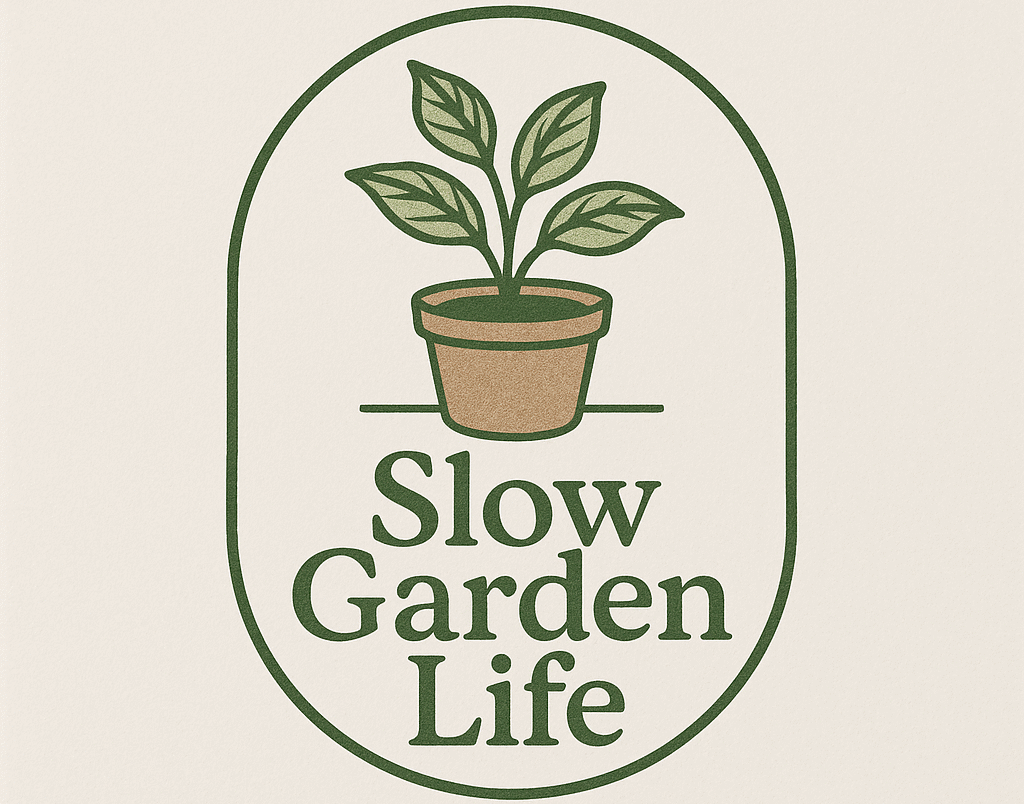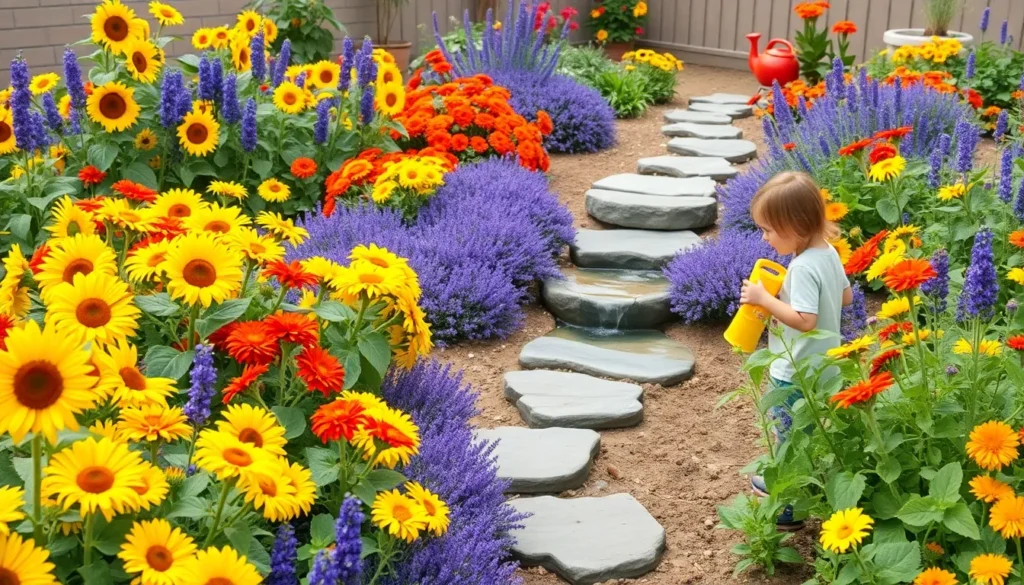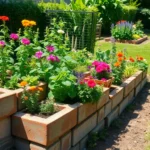Creating a magical nursery garden transforms any outdoor space into a wonderland where children can explore nature and develop a lifelong love for gardening. We’ve discovered that the perfect nursery garden combines safety with sensory experiences while encouraging little hands to dig in the dirt and watch seeds grow into beautiful plants.
A well-designed children’s garden isn’t just about pretty flowers – it’s about creating an interactive learning environment that captivates young minds. We’ll show you how to design spaces that spark curiosity through fragrant herbs kids can touch colorful vegetables they can harvest and whimsical features that make gardening feel like play.
Whether you’re working with a sprawling backyard or a small patio space we’ve gathered innovative ideas that’ll help you create an captivating outdoor classroom. From fairy gardens that ignite imagination to pizza gardens that teach about ingredients these concepts will transform your space into a place where children naturally gravitate toward nature’s wonders.
Start With Easy-to-Grow Vegetables for Beginner Success
Building on our nursery garden foundation, we’ll focus on vegetables that practically guarantee success for young gardeners. Simple crops create confidence while teaching essential gardening skills that children will treasure for years.
Choose Fast-Growing Radishes and Lettuce
Radishes emerge from soil in just 3-4 weeks, making them perfect for impatient little hands. We recommend Cherry Belle and French Breakfast varieties because they mature quickly and offer mild flavors that appeal to children. Planting these speedy vegetables creates immediate excitement as kids witness daily growth changes.
Lettuce provides continuous harvests throughout the growing season with proper succession planting. Buttercrunch and Black Seeded Simpson varieties thrive in various weather conditions while producing tender leaves perfect for young taste buds. Cut and come again harvesting teaches children sustainable gardening practices while keeping fresh greens on the family table.
Plant Hardy Root Vegetables Like Carrots
Carrots develop underground treasures that create natural excitement during harvest time. Paris Market and Chantenay varieties work exceptionally well in containers and raised beds where children can easily observe their progress. These sturdy vegetables tolerate temperature fluctuations while developing sweet flavors that encourage healthy eating habits.
Root development happens over 70-80 days, teaching patience while building anticipation for the final reveal. We suggest marking planting areas with colorful stakes so young gardeners remember where their orange treasures grow beneath the surface.
Try Low-Maintenance Herbs Like Basil and Mint
Basil thrives with minimal care while producing aromatic leaves that engage multiple senses during nursery garden exploration. Sweet basil and purple ruffles varieties create visual interest through different colors and textures. Pinching flowers encourages continued leaf production while teaching children proper plant maintenance techniques.
Mint spreads rapidly in contained spaces, making it ideal for enthusiastic beginning gardeners who want immediate results. Spearmint and chocolate mint varieties offer unique scents that captivate young noses while providing ingredients for homemade teas and recipes. Container growing prevents aggressive spreading while maintaining easy access for frequent harvesting sessions.
Create Colorful Flower Beds That Captivate Young Minds
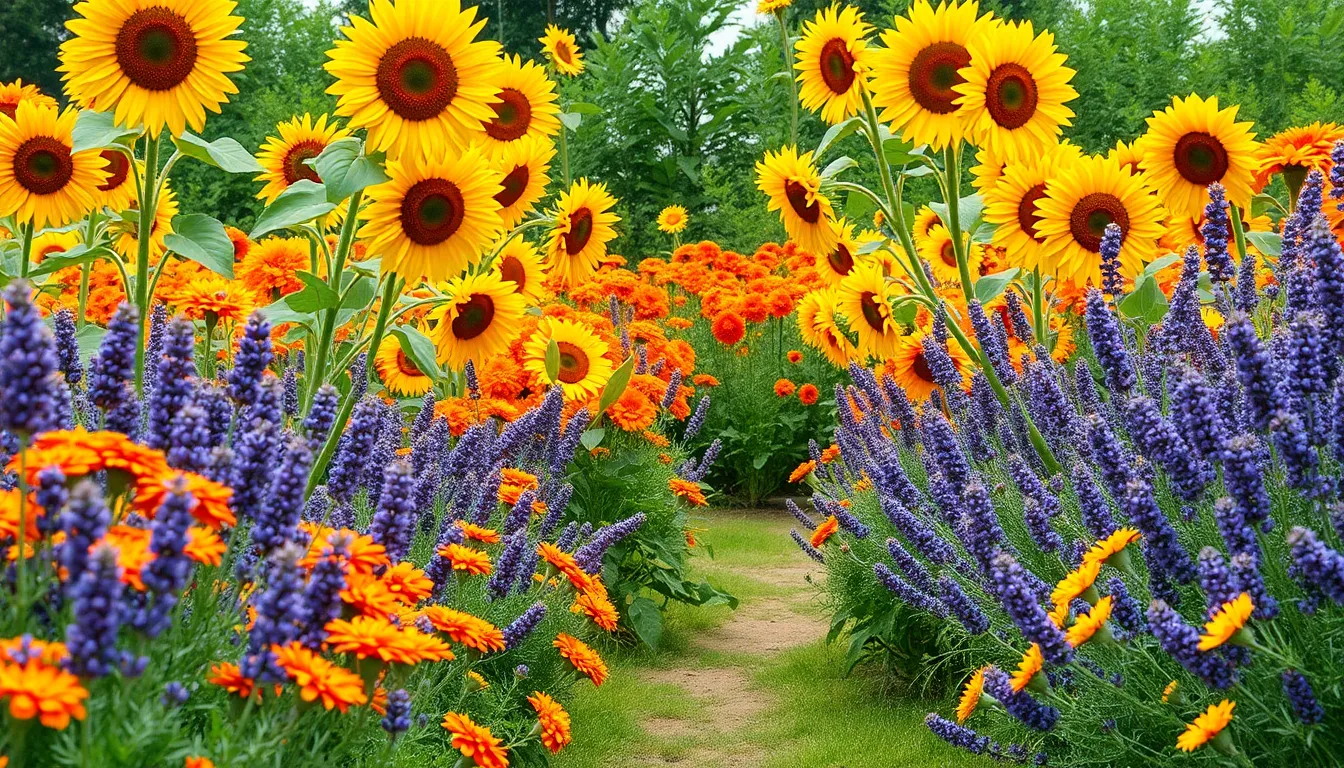
We can transform any nursery garden into a vibrant playground by designing colorful flower beds that stimulate curiosity and encourage exploration. Children naturally gravitate toward bright, bold displays that create strong visual centers of attention.
Plant Bright Sunflowers for Visual Impact
Sunflowers stand as perfect centerpiece plants for nursery gardens due to their impressive height and cheerful yellow blooms. We recommend positioning these giants where children can easily observe their growth progression throughout the season. Their large flower heads create dramatic focal points that naturally draw young eyes upward.
Planting sunflowers in small clusters amplifies their visual effect and provides multiple viewing angles for curious children. We’ve found that arranging 3-5 sunflowers together creates the most striking display while maintaining manageable garden space. Children love measuring themselves against these towering beauties as they grow taller each week.
Add Marigolds for Vibrant Orange and Yellow Hues
Marigolds complement sunflowers perfectly by filling garden beds with warm, inviting colors that children find irresistible. We plant these hardy flowers in playful shapes like hearts or spirals to create whimsical patterns that spark imagination. Their compact size makes them ideal for smaller hands to tend and observe closely.
Clustering marigolds in groups of 7-10 plants maximizes their color impact and creates stunning visual displays throughout the growing season. We choose varieties in bright orange and golden yellow to maintain the warm color scheme that energizes young gardeners. These reliable bloomers continue producing flowers from spring until the first frost.
Include Sweet-Smelling Lavender for Sensory Experience
Lavender brings essential sensory engagement to nursery gardens through its distinctive fragrance and soft, touchable texture. We position lavender plants along garden pathways where children can brush against them and release their calming scent. This aromatic herb reinforces learning through multiple senses beyond just visual observation.
Encouraging children to gently touch and smell lavender blossoms creates memorable garden experiences that promote deeper nature connections. We plant lavender in accessible locations where small hands can easily reach without damaging other garden plants. The purple flowers add beautiful color contrast while the scent promotes a peaceful garden atmosphere perfect for quiet observation moments.
Design Interactive Learning Stations Throughout the Garden

We can transform our nursery garden into a ever-changing educational environment by creating distinct stations that encourage hands-on STEM learning. These interactive zones promote teamwork, curiosity, and responsibility while making gardening enjoyable for children of all ages.
Build a Weather Monitoring Corner
We recommend establishing a dedicated weather station equipped with child-friendly devices that make meteorology accessible and exciting. Rain gauges, thermometers, and wind vanes provide children with tools to record daily weather conditions and observe environmental patterns. This hands-on approach helps young learners understand how weather directly affects plant growth and garden health.
Children can rotate through this station to collect data, document their observations, and develop scientific inquiry skills. We suggest providing weather journals where kids can track temperature changes, rainfall amounts, and wind patterns over time. This activity integrates multiple science concepts while teaching data recording and environmental observation skills that support classroom learning objectives.
Set Up a Composting Education Area
We can designate a exact area within our garden to teach composting using bins designed for organic waste management. This station allows children to observe the decomposition process firsthand while learning about recycling organic materials and understanding sustainability principles. Kids can witness how kitchen scraps and garden waste transform into nutrient-rich soil amendments.
The composting area highlights soil health concepts and introduces environmental responsibility in practical ways. We recommend using clear bins or open systems where children can see the decomposition stages, from fresh organic matter to finished compost. This station teaches patience, environmental stewardship, and the circular nature of garden ecosystems.
Create Plant Life Cycle Observation Spots
We should establish exact garden areas where children can monitor complete plant life cycles from seed germination to maturity. These dedicated spots come equipped with magnifying glasses, observation journals, and labeled markers to support detailed scientific study. Children can plant seeds, track germination progress, and document growth stages through structured activities that reinforce plant biology basics.
These observation areas support scientific inquiry by encouraging children to ask questions, make predictions, and record their findings. We can organize these spots to feature different plants with varying growth rates, allowing children to compare development patterns and understand biological diversity. This approach transforms passive observation into active scientific investigation that builds critical thinking skills.
Incorporate Child-Sized Garden Tools and Equipment

Equipping our nursery garden with properly sized tools transforms gardening from a frustrating challenge into an exciting adventure for young children. We’ve found that when children can comfortably handle their gardening equipment, they’re more likely to develop confidence and enthusiasm for nurturing plants.
Install Raised Beds at Appropriate Heights
Positioning raised beds at child-friendly heights ensures our young gardeners can actively participate without strain or difficulty. We recommend building beds between 12 to 18 inches high for toddlers and preschoolers, which allows them to reach comfortably while standing or kneeling. Tables constructed at 24 to 30 inches work perfectly for older children who prefer working while standing.
Accessibility becomes crucial when we consider different age groups using the same space. Wider bed edges provide stable surfaces where children can sit or lean while planting seeds, watering seedlings, or harvesting vegetables. We’ve discovered that beds with 6 to 8 inch wide tops give children the support they need during longer gardening sessions.
Provide Lightweight Watering Cans and Hand Tools
Selecting tools specifically designed for small hands prevents fatigue and encourages independent gardening activities. We choose watering cans that hold no more than 1 to 2 cups of water, ensuring children can lift and pour them easily without creating overwhelming messes. Plastic watering cans work better than metal ones because they’re lighter and won’t hurt little fingers if dropped.
Hand tools like trowels, cultivators, and pruning shears should feature shorter handles and ergonomic grips designed for developing motor skills. We prioritize tools with bright colors that appeal to children while remaining functional for actual gardening tasks. Safety becomes paramount when we select child appropriate tools with rounded edges and non-sharp points.
Add Small Garden Benches for Rest and Observation
Creating comfortable resting spots throughout our nursery garden encourages children to pause and observe the natural industry around them. We install benches at heights between 10 to 12 inches, perfect for young children to climb onto independently while keeping their feet touching the ground. Weatherproof materials like cedar or recycled plastic ensure our benches withstand outdoor conditions year round.
Strategic placement of these observation points allows children to watch butterflies, examine plant growth, or simply rest between active gardening tasks. We position benches near fragrant herbs, colorful flower displays, or vegetable plots to maximize learning opportunities during quiet moments. Benches also serve as perfect spots for adults to sit alongside children, sharing gardening knowledge and creating meaningful connections with nature.
Plan Seasonal Activities to Maintain Year-Round Interest
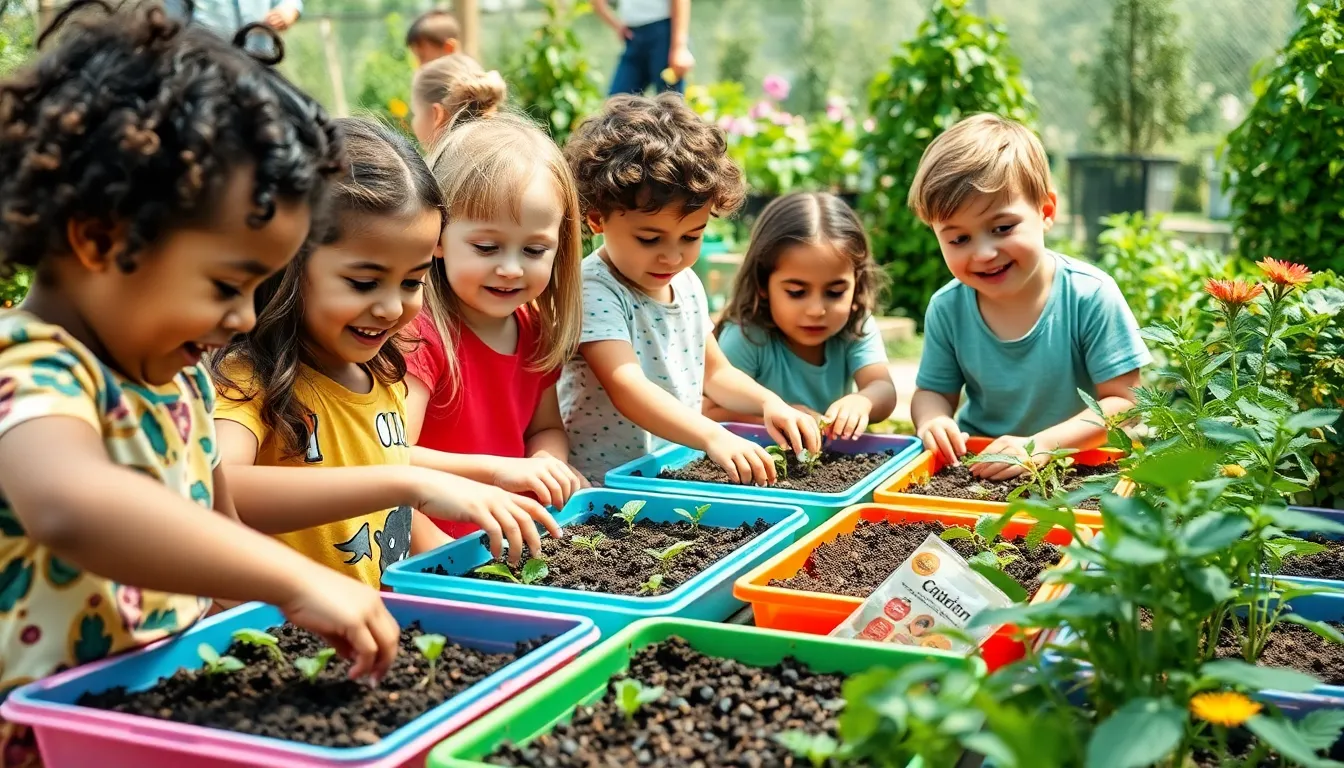
Creating year-round engagement in our nursery garden means planning activities that align with natural growing cycles and seasonal changes. We’ll maintain children’s interest by rotating activities that complement each season’s unique opportunities.
Spring Seed Starting Projects
Spring seed starting transforms our nursery garden into an exciting laboratory where children witness the miracle of germination firsthand. We use sterile, soilless potting media such as sphagnum peat moss mixed with vermiculite to create optimal growing conditions free of weeds and diseases. Seed starting trays filled with this specialized mix provide the perfect environment when placed in warm locations with sufficient light.
Planting seeds at their recommended depth ensures healthy germination, with most varieties requiring one seed per cell for proper spacing. We label each variety to help children track different plant types and learn organizational skills. Grouping seedlings from similar plant families streamlines our care routine while teaching botanical relationships. Common spring projects include starting vegetables like tomatoes and peppers, or herbs like basil and cilantro that we’ll later transplant outdoors.
Children develop patience and observation skills as they monitor daily progress and maintain consistent moisture levels. We create excitement by choosing fast-germinating varieties like lettuce and radishes that show results within days.
Summer Harvesting and Cooking Activities
Summer transforms our seed starting efforts into tangible rewards through harvesting and culinary adventures. We transplant our carefully nurtured seedlings outdoors where they flourish in warm weather and longer daylight hours. Fresh vegetables, herbs, and flowers become ready for harvest as they reach maturity throughout the growing season.
Cooking activities using garden fresh produce create powerful connections between growing and eating healthy foods. We prepare simple recipes featuring harvested herbs in homemade pestos or fresh vegetable salads that showcase our gardening success. Children experience pride when they taste food they’ve grown themselves from tiny seeds.
Garden to table activities reinforce the value of fresh, homegrown produce while teaching basic cooking skills. We incorporate measuring, mixing, and food preparation techniques that complement our gardening lessons. Summer harvesting sessions become treasure hunts as children search for ripe tomatoes, ready cucumbers, and fragrant herbs.
Fall Leaf Collection and Nature Crafts
Fall activities shift our focus from growing to gathering as we collect natural materials for creative projects. We gather fallen leaves in various shapes, sizes, and colors to create educational create opportunities. Leaf rubbings reveal intricate vein patterns while teaching about plant structure and seasonal changes.
Nature collages using collected leaves, acorns, and seed pods encourage artistic expression while reinforcing botanical learning. We create seasonal decorations that celebrate autumn’s beauty and help children appreciate natural cycles. This season also provides perfect timing for preparing our garden beds through composting activities.
Fallen leaves become valuable compost material that enriches our soil for next year’s growing season. We teach children about decomposition processes while building healthy garden foundations. Fall preparation activities help children understand how gardens rest and regenerate during winter months, completing our year-round learning cycle.
Include Educational Signage and Plant Labels
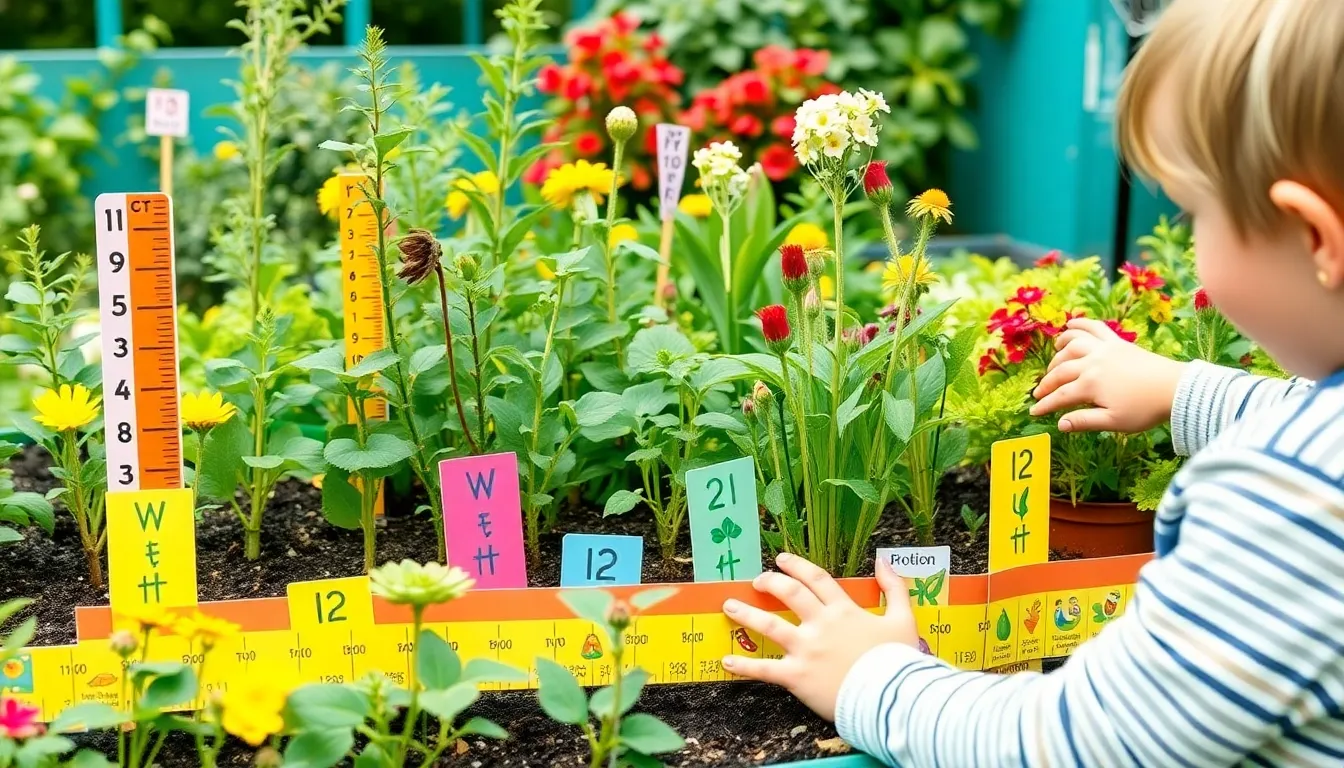
Educational signage transforms our nursery garden into an interactive learning environment that engages young minds while they explore. Well-placed signs and labels help children develop reading skills, scientific vocabulary, and deeper connections with the plants they’re growing.
Create Weather-Resistant Plant Identification Cards
Weather-resistant plant identification cards provide essential information that survives outdoor conditions throughout growing seasons. We recommend using laminated materials or waterproof cardstock to ensure durability against rain, sun, and snow. These cards should feature the plant’s common name, scientific name, and fun facts that capture children’s attention.
Digital scanning codes enhance our plant labels by linking to detailed educational resources about growth requirements, harvesting tips, and ecological benefits. QR codes connect children to videos, interactive games, and additional learning materials that extend the garden experience beyond physical exploration. Parents and educators can access comprehensive planting guides, seasonal care instructions, and age-appropriate activities through these digital connections.
Tactile elements on identification cards encourage hands-on exploration through texture samples, seed attachments, or raised lettering. Children learn to identify plants through multiple senses while developing fine motor skills and observation techniques. These interactive features make plant identification memorable and captivating for visual, tactile, and kinesthetic learners.
Add Growth Chart Markers for Tracking Progress
Growth chart markers teach children about plant development stages while encouraging regular garden observation and measurement skills. We suggest using colorful stakes or permanent markers placed next to plants to track height changes over time. Children can record measurements weekly in garden journals, creating personal connections with their growing plants.
Tracking progress through visual markers helps young gardeners understand concepts like germination rates, growth spurts, and seasonal variations in plant development. Comparison charts between different plant varieties demonstrate how environmental factors affect growth patterns. These observations build scientific thinking skills and encourage patience as children wait for harvest time.
Monthly photo documentation combined with height measurements creates lasting memories of gardening achievements while reinforcing measurement concepts and data collection skills. Children develop pride in their accomplishments when they see visual evidence of successful plant care and growth milestones.
Install Simple Garden Rules and Safety Signs
Simple garden rules posted at eye level for children establish clear expectations for respectful interaction with plants and garden spaces. We recommend using bright colors and picture symbols alongside text to communicate guidelines like “Stay on paths,” “Ask before picking,” and “Gentle touches only.” These visual reminders help children navigate the garden independently while protecting both plants and young visitors.
Safety reminders displayed prominently throughout the garden teach essential hygiene practices and hazard awareness without creating fear of exploration. Signs reading “Wash hands after gardening” and “Watch for bees and beneficial insects” promote safe interactions while encouraging respect for garden wildlife. Clear instructions about tool usage and plant handling prevent accidents while building confidence in garden activities.
Themed signs featuring watercolor designs or garden-related artwork engage children visually while communicating important information about garden etiquette and plant care. Interactive sign activities, such as having students create their own rule posters, reinforce learning through creative expression and personal investment in garden success.
Design Pathways That Encourage Safe Exploration
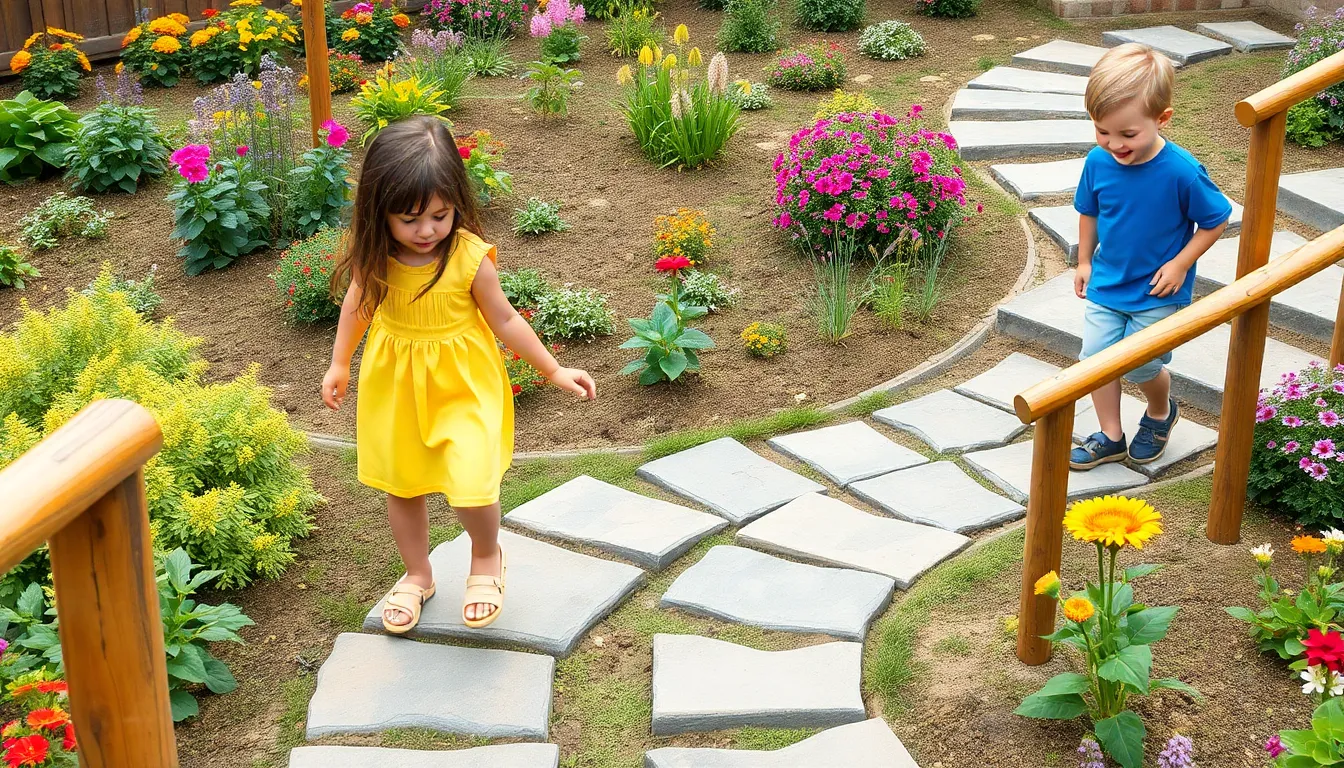
Well-designed pathways provide structure and guide movement while reducing the risk of children wandering into unsafe areas. Strategic pathway design creates opportunities for discovery while maintaining safety throughout your nursery garden space.
Use Stepping Stones for Defined Walking Areas
Stepping stones clearly mark safe paths through the garden and provide a tactile experience for children’s developing senses. They help children distinguish walking areas from plant beds or play zones, reducing trampling of plants while keeping play spaces and pathways distinct. Natural stone materials create visual appeal while offering slip-resistant surfaces that remain stable in various weather conditions. Strategic placement of stepping stones allows us to create designated routes that lead children safely between different garden activities and learning stations.
Create Curved Paths to Add Visual Interest
Curved pathways add visual interest and invite discovery by creating a sense of mystery that encourages children to follow the route. This design approach slows movement naturally, allowing children to explore different corners of the garden while supporting observation and play opportunities. Gentle curves make the garden feel larger and more inviting, promoting exploration while maintaining order and safety throughout the space. Winding paths create multiple vantage points where children can observe plants, insects, and seasonal changes from different perspectives.
Install Handrails Where Needed for Stability
Handrails offer essential support and prevent falls where pathways include changes in elevation or slopes, especially for young children who need extra stability. Wood or recycled materials work well for handrail construction, providing ecological benefits while maintaining visual appeal throughout the garden design. Proper handrail height ensures children can grasp them comfortably while handling uneven terrain or transitional areas between different garden zones. Strategic handrail placement near raised beds, steps, or sloped areas creates confidence for independent exploration while maintaining supervision accessibility for adults.
Add Water Features for Both Beauty and Learning
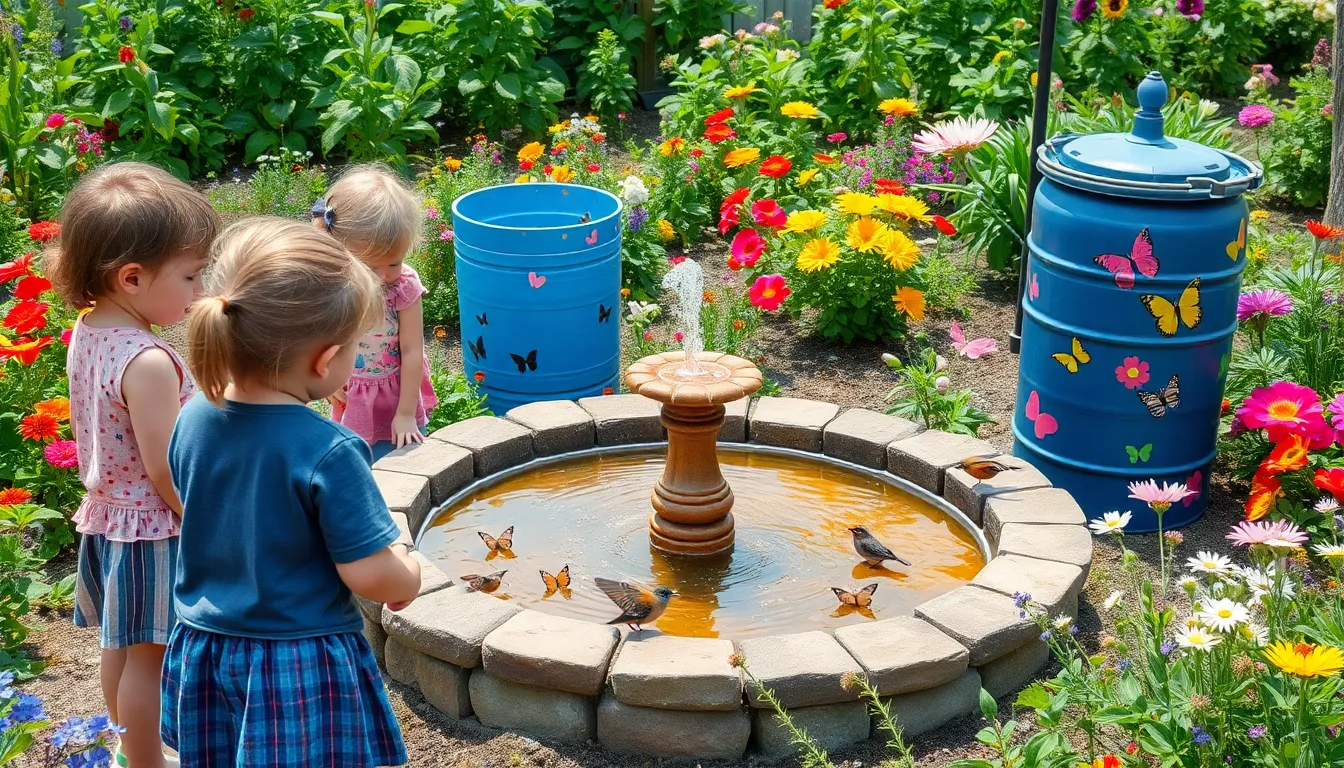
Water elements transform any nursery garden into a multisensory learning environment while creating focal points that naturally draw children’s attention. Incorporating these features enhances both the aesthetic appeal and educational value of our garden space.
Include a Small Fountain for Sound and Movement
Small fountains serve as captivating centerpieces that provide soothing sounds and mesmerizing visual movement for developing minds. We recommend positioning these water features near seating areas where children can observe and listen while taking breaks from gardening activities.
Bubbling fountains create gentle background sounds that help mask neighborhood noise while teaching children about water flow and pressure. Installing solar-powered options eliminates the need for electrical connections and demonstrates renewable energy concepts to young learners.
Recirculating fountain systems use minimal water while providing maximum sensory engagement through continuous movement and sound. Children naturally gravitate toward these features, making them perfect gathering spots for group discussions about plants, weather, and nature observations.
Set Up Rain Collection Barrels for Conservation Education
Rain collection barrels offer hands-on lessons about water conservation and sustainable gardening practices that children can easily understand and carry out. We suggest decorating these containers with bright colors or fun designs to make water collection more appealing to young gardeners.
Installing child-friendly spigots at appropriate heights allows kids to fill their watering cans independently while learning about water recycling. These systems demonstrate how we can reduce waste by capturing natural precipitation for later use in the garden.
Measuring rainfall collection becomes an exciting math activity as children track weekly water accumulation and calculate usage for different plants. Clear measuring marks on the barrels help kids visualize water levels and understand conservation principles through practical application.
Educational opportunities expand when we connect rain collection to weather patterns, helping children understand seasonal variations and their impact on plant growth cycles.
Create Shallow Water Dishes for Wildlife Observation
Shallow water dishes attract local wildlife species like birds and butterflies, transforming our nursery garden into a natural observation laboratory. We recommend using dishes no deeper than 2 inches to ensure safety while providing adequate water sources for various creatures.
Positioning these water features at different heights creates diverse viewing opportunities, with ground-level dishes attracting ground-feeding birds and elevated options welcoming perching species. Adding small stones or pebbles creates landing spots for insects and provides grip for visiting animals.
Regular water changes keep these features fresh while teaching children about hygiene and animal care responsibilities. Kids develop observation skills by watching which animals visit throughout different times of day and seasons.
Strategic placement near flowering plants increases wildlife activity, as pollinators and other beneficial insects use water sources during their garden visits. This creates natural connections between water conservation, plant health, and network relationships that children can witness firsthand.
Conclusion
Creating a thriving nursery garden opens up endless possibilities for captivating young minds with nature. We’ve explored how thoughtful planning transforms any outdoor space into an educational playground where children can learn through hands-on experiences.
The key lies in balancing safety with sensory engagement while incorporating age-appropriate tools and interactive elements. From colorful flower beds to weather monitoring stations these features work together to create memorable learning opportunities.
Remember that success comes from starting small and building upon each positive experience. Whether you’re working with a sprawling backyard or a compact patio the principles remain the same – make it accessible captivating and fun.
Your nursery garden will become a foundation for lifelong learning fostering curiosity responsibility and a deep connection with the natural industry that will benefit children for years to come.
Frequently Asked Questions
What is a magical nursery garden?
A magical nursery garden is an outdoor space specifically designed to engage children with nature through interactive, sensory experiences. It combines safety with educational elements like fragrant herbs, colorful vegetables, and whimsical features to captivate young minds and foster a love for gardening in children of all ages.
What are the best vegetables for children to grow?
Fast-growing vegetables like radishes (mature in 3-4 weeks) and lettuce are perfect for young gardeners as they provide quick results. Hardy root vegetables like carrots create anticipation during harvest, while easy-to-grow herbs such as basil and mint offer sensory engagement and require minimal maintenance.
How can I create colorful flower beds that appeal to children?
Plant sunflowers as impressive centerpieces arranged in clusters for maximum visual impact. Add marigolds for warm colors and playful shapes, and include lavender for its fragrance and texture. These vibrant displays stimulate curiosity and create memorable experiences that promote deeper connections with nature.
What interactive learning stations should I include in a children’s garden?
Create a weather monitoring corner with child-friendly devices, establish a composting education area to teach sustainability, and set up plant life cycle observation spots. These interactive zones promote hands-on STEM learning, encourage scientific inquiry, and develop critical thinking skills while making gardening enjoyable.
What tools and equipment are best for young gardeners?
Use lightweight watering cans and hand tools designed for small hands to prevent fatigue. Install raised beds at appropriate heights for different age groups, and add small garden benches for observation and rest. Child-sized equipment ensures accessibility and encourages independent gardening activities.
How can I maintain year-round interest in the nursery garden?
Plan seasonal activities: spring seed starting projects, summer harvesting and cooking activities, and fall craft projects with natural materials. Include composting activities and growth tracking throughout the year. These seasonal cycles keep children engaged and deepen their understanding of gardening and nature.
What educational signage should I include in the garden?
Use weather-resistant plant identification cards with fun facts and QR codes for additional resources. Add tactile elements and growth chart markers to help children track plant development. Include simple garden rules and safety signs to establish clear expectations and promote safe interaction with the garden.
How should I design pathways for safe exploration?
Create well-designed pathways using stepping stones to clearly mark walking areas and prevent plant trampling. Use curved paths to add visual interest and invite discovery. Install handrails in areas with elevation changes to provide stability and support for young children during garden exploration.
What water features can enhance a children’s garden?
Add small fountains for soothing sounds and visual movement that teach water flow concepts. Install rain collection barrels for hands-on water conservation lessons and independent watering activities. Include shallow water dishes to attract wildlife, creating opportunities for observation and teaching about ecosystem interconnectedness.
How much space do I need for a nursery garden?
Nursery gardens can be adapted to any space, from large backyards to small patios. The article provides innovative ideas for various spaces, including concepts like fairy gardens and pizza gardens. The key is creating interactive, sensory experiences regardless of the available area.
